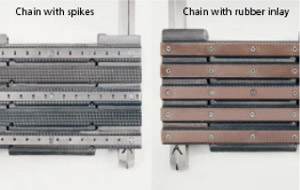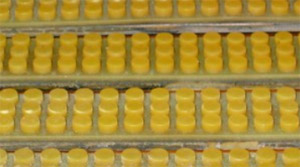| |
Chain Track Pad Case Study
RUBBER-TO-METAL BONDING - Woodworking Application
|
Issue: An internationally renowned craftsman of fine furniture approached us needing to improve the durability of a rubber coated friction pad used on its dip chain multiple rip saw. The OEM offered two styles of pads, a chain with spikes and a chain with a rubber inlay. The spiked chain while very durable, caused more defects and rejects and at times the spike left unwanted marks in the wood surface. The rubber-covered chain adhered to the metal using a pressure sensitive adhesive. While the rubberized chain did not mark the wood, the adhesive broke down quickly causing the rubber surface to detiorate and required complete shutdown and replacement of the chains approximately every month. Machine downtime and the cost of the replacement chains were unacceptable.
|
 |
|
Objective: The objective was to develop a chain track pad that would not mark the wood, eliminating material defects while providing longer run times of each set of friction pads to reduce machine downtime.
|
|
J.J. Short Processes: We recommended a nub-type surface pattern similar to the spiked surface pattern using a millable urethane which provided the desired non-slip, non-marking surface. We produced a mold and the metal bars and manufactured the part (metal and rubber) complete with the surface pattern bonded to the metal surface. The mold remains at our facility for the exclusive use by our customer!
|
 |
| |
|
|
Results: Incredible! Our initial order was for 2 sets (64 pcs) of chain track pads for each machine -1 to install and 1 for maintenance. After 18 months of regular use the original friction pads are still in use and the second set remains on the shelf! The customer has asked us to apply similar rubber-to-metal bonding processes on track pads of various sizes in different applications throughout their plant!
|
 |
Woodworking Equipment Parts for more woodworking equipment rubber part applications!
If it's made from rubber,
contact us!
|
|